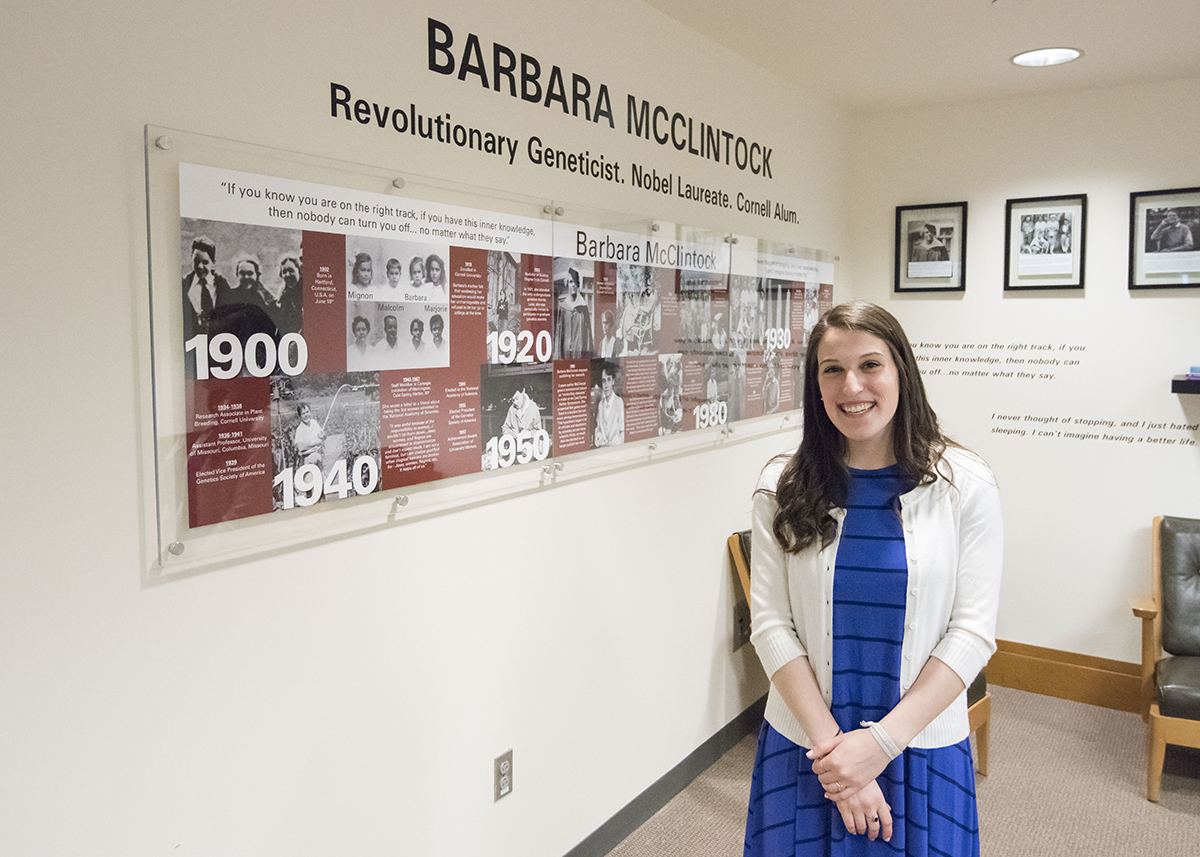Senior honors Nobel laureate McClintock with library display
By Matt Hayes

It took nearly 40 years for Barbara McClintock ’23, M.A. ’25, Ph.D. ’27, to be recognized for her groundbreaking research, winning the 1983 Nobel Prize for work she completed in the 1940s.
Now after another 30 years, Cornell has a prominent display marking the achievements of a scientist who discovered one of the most fundamental aspects of genetics.
And it’s all thanks to the persistence of Juliet Jacobson ’16.
Jacobson, a senior studying biological sciences in the College of Agriculture and Life Sciences, first learned of McClintock’s achievements while in high school. When she arrived at Cornell she expected to find a statue or other prominent marker commemorating a titan of science who earned three degrees at the university and later returned to teach. What she found instead was a plaque near the small space where McClintock conducted her research, far from popular spots on campus where wandering students might learn of her life and legacy.
“[McClintock] loved this school and called it home. I knew there should be a permanent place recognizing her accomplishments,” Jacobson said. “I promised myself I would not leave Cornell without making every attempt possible to have her properly honored.”
Her efforts finally found a toehold when she received a grant from the President’s Council of Cornell Women. The grant carved out space for a permanent exhibit on the third floor of Mann Library and gave Jacobson the resources she needed to turn archival material into a timeline marking McClintock’s achievements and the obstacles she faced.
McClintock came to Cornell at a time when few women entered scientific disciplines. She studied botany as an undergraduate in the College of Agriculture, then followed her interests into the emerging field of cytogenetics. Her pioneering research into maize genetics while at Cold Spring Harbor Laboratory led to the discovery of transposable elements, sections of DNA that can migrate to different parts of the genome and make up an estimated 90 percent of the maize genome and 44 percent of the human genome.
Her discovery in the decade before James Watson and Francis Crick deduced the double-helix structure of DNA met with skepticism from the scientific community. Complex and utterly novel, her findings were dismissed by fellow – mainly male – scientists, until improved technology confirmed her discovery decades later. She remains the only woman to receive an unshared Nobel Prize in physiology or medicine.
Her experience was typical of how female scientists were treated during that era.
“She was a scientist at a time when it wasn’t easy to be a woman in science,” Jacobson said. “She’s a perfect example of a woman who persevered.”

Mariana Wolfner, the Goldwin Smith Professor of Molecular Biology and Genetics, had the chance while a student at Cornell to work with slides created by McClintock. She later met the pre-eminent scientist in person while McClintock was an A.D. White Professor at Large at Cornell from 1965-74.
“She loved her research, and she was so brilliant,” Wolfner said during a May 4 panel featuring Cornell women faculty members discussing their experiences as women in science. “She was effectively either a mentor or an inspiration to many, many, many geneticists.”
Along with a timeline, the exhibit displays books about McClintock and inspirational quotes from the scientist, who died in 1992. Jacobson credited the help of postdoctoral student Sara Di Rienzi in amassing the material and planning the panel discussion and subsequent symposium.
Jacobson hopes the exhibit will be a source of inspiration to all students looking to overcome obstacles. Her tenacity starting as a freshman finally found results a few weeks before graduation.
“It took nearly 40 years before [McClintock] was recognized,” Jacobson said. “I figured I could wait four.”
Matt Hayes is managing editor and social media manager for the College of Agriculture and Life Sciences.
Media Contact
Get Cornell news delivered right to your inbox.
Subscribe